Acacia koa
Acacia koa is a species of flowering tree in the family Fabaceae. It is endemic to the Hawaiian Islands,[2] where it is the second most common tree.[3] The highest populations are on Hawaiʻi, Maui and Oʻahu. Its name in the Hawaiian language, koa, also means brave, bold, fearless, or warrior.[4]
| Acacia koa | |
|---|---|
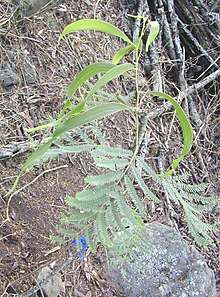 | |
| A young koa tree showing compound leaves and phyllodes | |
| Scientific classification | |
| Kingdom: | Plantae |
| Clade: | Tracheophytes |
| Clade: | Angiosperms |
| Clade: | Eudicots |
| Clade: | Rosids |
| Order: | Fabales |
| Family: | Fabaceae |
| Clade: | Mimosoideae |
| Genus: | Acacia |
| Species: | A. koa |
| Binomial name | |
| Acacia koa | |
| Synonyms[2] | |
|
Acacia heterophylla var. latifolia Benth. | |
Description
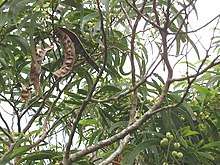
Koa is a large tree, typically attaining a height of 15–25 m (49–82 ft) and a spread of 6–12 m (20–39 ft).[5] In deep volcanic ash, a koa tree can reach a height of 30 m (98 ft), a circumference of 6 m (20 ft), and a spread of 38 m (125 ft).[6] It is one of the fastest-growing Hawaiian trees, capable of reaching 6–9 m (20–30 ft) in five years on a good site.[7]
Leaves
Initially, bipinnately compound leaves with 12–24 pairs of leaflets grow on the koa plant, much like other members of the pea family. At about 6–9 months of age, however, thick sickle-shaped "leaves" that are not compound begin to grow. These are phyllodes, blades that develop as an expansion of the leaf petiole. The vertically flattened orientation of the phyllodes allows sunlight to pass to lower levels of the tree. True leaves are entirely replaced by 7–25 cm (2.8–9.8 in) long, 0.5–2.5 cm (0.20–0.98 in) wide phyllodes on an adult tree.[5]
Flowers
Flowers of the koa tree are pale-yellow spherical racemes with a diameter of 8–10 mm (0.31–0.39 in).[8] Flowering may be seasonal or year round depending on the location.[5]
Fruit
Fruit production occurs when a koa tree is between 5 and 30 years old. The fruit are legumes, also called pods, with a length of 7.5–15 cm (3.0–5.9 in) and a width of 1.5–2.5 cm (0.59–0.98 in). Each pod contains an average of 12 seeds. The 6–12 mm (0.24–0.47 in) long, 4–7 mm (0.16–0.28 in) wide seeds are flattened ellipsoids and range from dark brown to black in color. The pods are mature and ready for propagation after turning from green to brown or black. Seeds are covered with a hard seed coat, and this allows them to remain dormant for up to 25 years. Scarification is needed before A. koa seeds will germinate.[8]
Habitat
Koa is endemic to the islands of Hawaiʻi, Molokaʻi, Maui, Lānaʻi, Oʻahu, and Kauaʻi, where it grows at elevations of 100–2,300 m (330–7,550 ft). It requires 850–5,000 mm (33–197 in) of annual rainfall. Acidic to neutral soils (pH of 4-7.4)[5] that are either an Inceptisol derived from volcanic ash or a well-drained histosol are preferred.[9] Its ability to fix nitrogen allows it to grow in very young volcanic soils.[3] Koa and ʻōhiʻa lehua (Metrosideros polymorpha) dominate the canopy of mixed mesic forests.[10] It is also common in wet forests.[11]
Uses
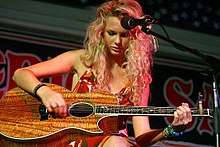
The koa's trunk was used by ancient Hawaiians to build waʻa (dugout outrigger canoes)[12] and papa heʻe nalu (surfboards). Only paipo (bodyboards), kikoʻo, and alaia surfboards were made from koa, however; olo, the longest surfboards, were made from the lighter and more buoyant wiliwili (Erythrina sandwicensis).[13] The reddish wood is very similar in strength and weight to that of Black Walnut (Juglans nigra), with a specific gravity of 0.55,[8] and is sought for use in wood carving and furniture.[5] Koa is also a tonewood,[14] often used in the construction of ukuleles,[15] acoustic guitars,[16] and Weissenborn-style Hawaiian steel guitars.[17] B.C. Rich used koa on some of their electric guitars as well,[18] and still uses a koa-veneered topwood on certain models.[19] Fender made limited edition koa wood models of the Telecaster and the Stratocaster in 2006. Trey Anastasio, guitarist for the band Phish, primarily uses a koa hollowbody Languedoc guitar. Commercial silviculture of koa takes 20 to 25 years before a tree is of useful size.[20]
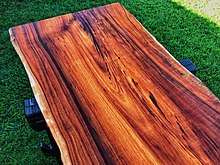
Relation to other species

Among other Pacific Islands of volcanic (non-continental) origin, only Vanuatu has native Acacia species. A. heterophylla, from distant Réunion, is very similar and has been suggested to be the closest relative of koa.[21] Genetic sequence analysis results announced in 2014 confirmed this close relationship; the estimated time of divergence is about 1.4 million years ago.[22][23] A. heterophylla sequences nest within those of the more diverse A. koa, making the latter paraphyletic.[23] Both species are thought to be descended from an ancestral species in Australia, presumably their sister species, Acacia melanoxylon. Dispersals most likely occurred via seed-carrying by birds such as petrels.[23] Both species have very similar ecological niches, which differ from that of A. melanoxylon.[23]
A closely related species, koaiʻa or koaiʻe (A. koaia), is found in dry areas. It is most easily distinguished by having smaller seeds that are arranged end-to-end in the pod, rather than side-by-side. The phyllodes are also usually straighter, though this character is variable in both species. The wood is denser, harder, and more finely grained than koa wood.[5] Koaiʻa has been much more heavily impacted by cattle and is now rare, but can be seen on ranch land in North Kohala.
Conservation
The koa population has suffered from grazing and logging. Many wet forest areas, where the largest koa grow, have been logged out, and it now comes largely from dead or dying trees or farms on private lands. Although formerly used for outrigger canoes, there are few koa remaining which are both large and straight enough to do so today.[5] In areas where cattle are present, koa regeneration is almost completely suppressed. However, if the cattle are removed, koa are among the few native Hawaiian plants able to germinate in grassland, and can be instrumental in restoring native forest. It is often possible to begin reforestation in a pasture by disk harrowing the soil, as this scarifies seeds in the soil and encourages large numbers of koa to germinate.[9] Experiments at the Hakalau Forest National Wildlife Refuge have shown that ʻōhiʻa lehua (Metrosideros polymorpha) survives best in pasture when planted under koa. This is because koa trees reduce radiative cooling, preventing frost damage to ʻōhiʻa lehua seedlings.[24]
Ecology
Koa is the preferred host plant for the caterpillars of the green Hawaiian blue (Udara blackburni), which eat the flowers and fruits.[25] Adults drink nectar from the flowers. Koa sap is eaten by the adult Kamehameha butterfly (Vanessa tameamea).[26] The koa bug (Coleotichus blackburniae) uses its rostrum to suck the contents out of koa seeds.[27] Koa is vulnerable to infection by koa wilt.
Gallery

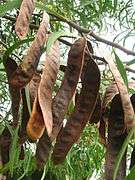
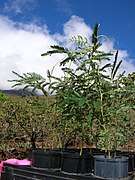

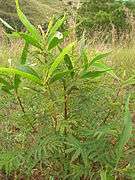
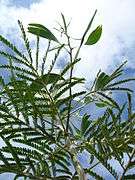

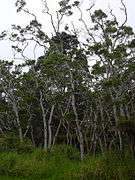

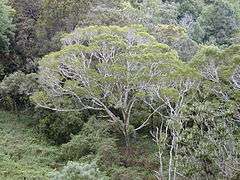

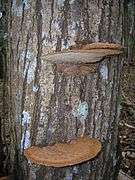

- Acacia koa with phyllode between the branch and the compound leaves
References
- Contu, S. 2012. Acacia koa. The IUCN Red List of Threatened Species 2012: e.T19891713A19999145. https://dx.doi.org/10.2305/IUCN.UK.2012.RLTS.T19891713A19999145.en. Downloaded 8 May 2017.
- "Acacia koa". Germplasm Resources Information Network (GRIN). Agricultural Research Service (ARS), United States Department of Agriculture (USDA). Retrieved 2010-05-03.
- Idol, Travis (2008-04-16). "Environmental Controls Over Acacia koa Productivity". Travis Idol's Research Page. University of Hawaiʻi at Mānoa. Retrieved 2009-01-31.
- Kepler, Angela Kay (1998). Hawaiian Heritage Plants. University of Hawaii Press. p. 106. ISBN 978-0-8248-1994-1.
- Elevitch, Craig R.; Kim M. Wilkinson; J. B. Friday; C. Baron Porter (April 2006). "Acacia koa (koa) and Acacia koaia (koaiʻa)" (PDF). The Traditional Tree Initiative. Cite journal requires
|journal=(help) - Welsbacher, Anne (2003). Life in a Rain Forest. Twenty-First Century Books. p. 30. ISBN 978-0-8225-4685-6.
- Wilkinson, Kim M.; Craig R. Elevitch (2003). Growing Koa: A Hawaiian Legacy Tree. Hōlualoa, Hawai'i: Permanent Agriculture Resources. p. 13. ISBN 978-0-9702544-2-9.
- Allen, James A. (2003-01-01). "Acacia koa A. Gray" (PDF). Tropical Tree Seed Manual. Reforestation, Nurseries & Genetics Resources. Retrieved 2009-02-23.
- Whitesell, Craig D (1990). "Acacia koa". In Burns, Russell M.; Honkala, Barbara H. (eds.). Hardwoods. Silvics of North America. Washington, D.C.: United States Forest Service (USFS), United States Department of Agriculture (USDA). 2. Archived from the original on 20 January 2009. Retrieved 2009-02-17 – via Southern Research Station (www.srs.fs.fed.us).
- Ziegler, Alan C. (2002). Hawaiian Natural History, Ecology, and Evolution. University of Hawaii Press. pp. 175–176. ISBN 978-0-8248-2190-6.
- Sohmer, S. H.; R. Gustafson (1987). Plants and Flowers of Hawaiʻi. University of Hawaii Press. pp. 45–52. ISBN 978-0-8248-1096-2.
- Bryan, William Alanson (1915). Natural History of Hawaii, Being an Account of the Hawaiian People, the Geology and Geography of the Islands, and the Native and Introduced Plants and Animals of the Group. Hawaiian Gazette Co, Ltd. p. 339. ISBN 978-1-4446-7820-8.
- Marcus, Ben; Juliana Morais; Jeff Divine; Gary Linden (2007). The Surfboard: Art, Style, Stoke. MBI Publishing Company. pp. 17–19. ISBN 978-0-7603-2753-1.
- Beberman, Norman L. "Koa: Beautiful Looking, Beautiful Sounding Tonewood". GuitarNation.com. Archived from the original on 7 February 2009. Retrieved 2009-02-23.
- Gernot Rödder (2002). Total Ukulele: D-Tuning Method for Beginners. Mel Bay Publications. p. 93. ISBN 978-3-8024-0446-7.
- Gerken, Teja (2000). Acoustic Guitar Owner's Manual: The Complete Guide. String Letter Publishing. p. 10. ISBN 978-1-890490-21-8.
- Sheperd, John (2003). "Guitars". Continuum Encyclopedia of Popular Music of the World. Volume II: Performance and Production. Continuum International Publishing Group. p. 283. ISBN 978-0-8264-6322-7.
- Achard, Ken (1989). The History and Development of the American Guitar. Bold Strummer Ltd. p. 163. ISBN 978-0-933224-18-6.
- Kirkland, Eric (December 2006). "Rich and Famous". Guitar World: 154.
- "Silviculture: Diversification of Rural Economy". Leeward Haleakalā Watershed Restoration Partnership. Retrieved 2009-02-01.
- Whitesell, Craig D (1964). "Silvical Characteristics of Koa (Acacia koa Gray)" (PDF). United States Forestry Service. Cite journal requires
|journal=(help) - Marris, E. (2014-06-19). "Tree hitched a ride to island". Nature. 510 (7505): 320–321. Bibcode:2014Natur.510..320M. doi:10.1038/510320a. PMID 24943937.
- Le Roux, J. J.; Strasberg, D.; Rouget, M.; Morden, C. W.; Koordom, M.; Richardson, D. M. (2014-06-18). "Relatedness defies biogeography: The tale of two island endemics (Acacia heterophyllaandA. Koa)". New Phytologist. 204 (1): 230–242. doi:10.1111/nph.12900. PMID 24942529.
- Friday, J. B.; Darrell A. Herbert (April 2006). "Metrosideros polymorpha ('ōhi'a lehua)" (PDF). The Traditional Tree Initiative: 21. Cite journal requires
|journal=(help) - Scott, James A. (1992). The Butterflies of North America: A Natural History and Field Guide. Stanford University Press. p. 399. ISBN 978-0-8047-2013-7.
- Scott, Susan (1991). Plants and Animals of Hawaii. Bess Press. p. 78. ISBN 978-0-935848-93-9.
- http://www.uhh.hawaii.edu/affiliates/prism/documents/KoaBugLesson.pdf
External links


- Photos of Acacia koa at Hawaiian Ecosystems at Risk Project (HEAR)
- UCLA botanical garden and home
- Historic photos and descriptions of Acacia koa
